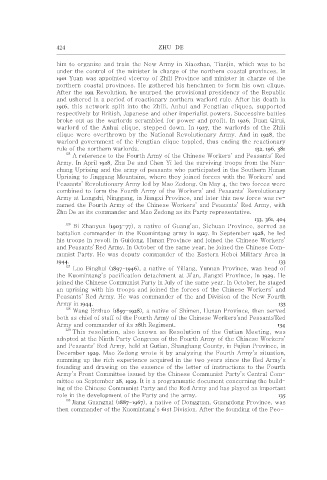Page 428 - SELECTED WORKS OF ZHU DE
P. 428
424 ZHU DE
him to organize and train the New Army in Xiaozhan, Tianjin, which was to be
under the control of the minister in charge of the northern coastal provinces. In
1901 Yuan was appointed viceroy of Zhili Province and minister in charge of the
northern coastal provinces. He gathered his henchmen to form his own clique.
After the 1911 Revolution, he usurped the provisional presidency of the Republic
and ushered in a period of reactionary northern warlord rule. After his death in
1916, this network split into the Zhili, Anhui and Fengtian cliques, supported
respectively by British, Japanese and other imperialist powers. Successive battles
broke out as the warlords scrambled for power and profit. In 1926, Duan Qirui,
warlord of the Anhui clique, stepped down. In 1927, the warlords of the Zhili
clique were overthrown by the National Revolutionary Army. And in 1928, the
warlord government of the Fengtian clique toppled, thus ending the reactionary
rule of the northern warlords. 132, 196, 381
125
A reference to the Fourth Army of the Chinese Workers’ and Peasants’ Red
Army. In April 1928, Zhu De and Chen Yi led the surviving troops from the Nan-
chang Uprising and the army of peasants who participated in the Southern Hunan
Uprising to Jinggang Mountains, where they joined forces with the Workers’ and
Peasants’ Revolutionary Army led by Mao Zedong. On May 4, the two forces were
combined to form the Fourth Army of the Workers’ and Peasants’ Revolutionary
Army at Longshi, Ninggang, in Jiangxi Province, and later this new force was re-
named the Fourth Army of the Chinese Workers’ and Peasants’ Red Army, with
Zhu De as its commander and Mao Zedong as its Party representative.
133, 361, 404
126 Bi Zhanyun (1903-77), a native of Guang’an, Sichuan Province, served as
battalion commander in the Kuomintang army in 1927. In September 1928, he led
his troops in revolt in Guidong, Hunan Province and joined the Chinese Workers’
and Peasants’ Red Army. In October of the same year, he joined the Chinese Com-
munist Party. He was deputy commander of the Eastern Hebei Military Area in
1944. 133
127 Luo Binghui (1897-1946), a native of Yiliang, Yunnan Province, was head of
the Kuomintang’s pacification detachment at Ji’an, Jiangxi Province, in 1929. He
joined the Chinese Communist Party in July of the same year. In October, he staged
an uprising with his troops and joined the forces of the Chinese Workers’ and
Peasants’ Red Army. He was commander of the 2nd Division of the New Fourth
Army in 1944. 133
128
Wang Erzhuo (1897-1928), a native of Shimen, Hunan Province, then served
both as chief of staff of the Fourth Army of the Chinese Workers’ and Peasants’ Red
Army and commander of its 28th Regiment. 134
129
This resolution, also known as Resolution of the Gutian Meeting, was
adopted at the Ninth Party Congress of the Fourth Army of the Chinese Workers’
and Peasants’ Red Army, held at Gutian, Shanghang County, in Fujian Province, in
December 1929. Mao Zedong wrote it by analysing the Fourth Army’s situation,
summing up the rich experience acquired in the two years since the Red Army’s
founding and drawing on the essence of the letter of instructions to the Fourth
Army’s Front Committee issued by the Chinese Communist Party’s Central Com-
mittee on September 28, 1929. It is a programmatic document concerning the build-
ing of the Chinese Communist Party and the Red Army and has played an important
role in the development of the Party and the army. 135
130
Jiang Guangnai (1887-1967), a native of Dongguan, Guangdong Province, was
then commander of the Kuomintang’s 61st Division. After the founding of the Peo-

